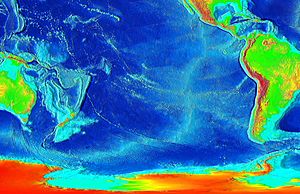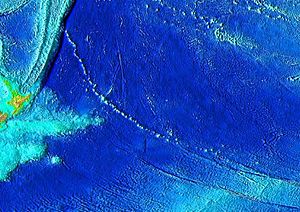Pacific-Antarctic Ridge facts for kids

The Pacific-Antarctic Ridge (PAR) is a huge underwater mountain range in the South Pacific Ocean. It's like a giant crack on the ocean floor where two enormous pieces of Earth's crust, called tectonic plates, are slowly pulling apart. This boundary separates the Pacific Plate from the Antarctic Plate.
Some people think of the Pacific-Antarctic Ridge as the southern part of an even bigger underwater mountain range called the East Pacific Rise. It stretches from the Challenger Fracture Zone all the way down to the Macquarie Triple Junction, which is south of New Zealand.
How the Ridge Was Formed
The Pacific-Antarctic Ridge is a special type of place called a divergent plate boundary. This means the two tectonic plates are moving away from each other. When this happens, hot, melted rock (called magma) rises up from deep inside the Earth. This magma cools and hardens, creating new ocean floor. This process slowly pushes the plates apart, making the ocean basin wider over millions of years.
The Louisville Ridge
Stretching for about 4,300 kilometers (2,670 miles) from the Pacific-Antarctic Ridge is a very long line of underwater mountains called the Louisville Ridge. These underwater mountains are also known as seamounts. It's the longest chain of seamounts in the Pacific Ocean!
Scientists believe the Louisville Ridge formed because the Pacific Plate slowly moved over a special spot deep in the Earth called the Louisville hotspot. A hotspot is like a fixed "plume" of very hot magma rising from deep inside the Earth. As the plate moves over this hotspot, the magma melts through the crust and erupts, building up new seamounts one after another, like a trail of volcanic islands.
See also
- Oceanic ridge
- List of tectonic plate interactions
- In Spanish: Dorsal Pacífico-Antártica para niños


